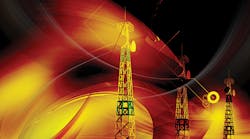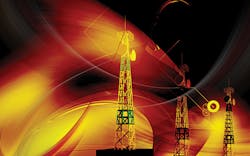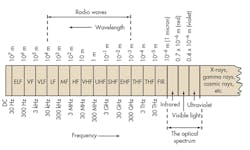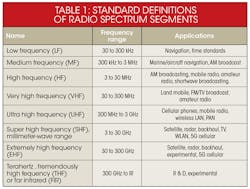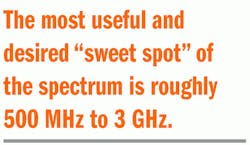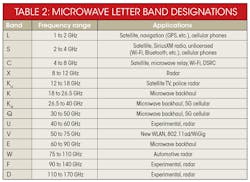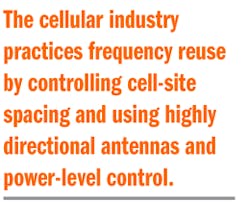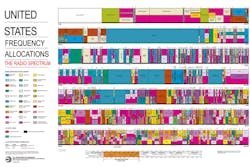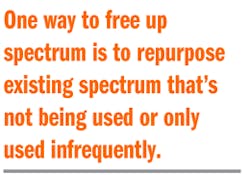This file type includes high-resolution graphics and schematics when applicable.
Spectrum is everything when it comes to choosing or designing wireless equipment. Knowledge of the electromagnetic (EM) spectrum is essential for all engineers working with wireless equipment and systems. It affects what you can transmit as well as how and where, determining everything from rates and range to capabilities and cost. Sometimes you can choose from several options, and other times you’re limited to one. If you’re not a spectrum wonk, then it’s time to become one. This primer on spectrum will help get you started.
What Is Spectrum?
Radio signals travel in the free space known as spectrum. Some have called it the ether. More precisely, it’s that distribution of electromagnetic signals over a wide frequency range where all radio emissions occur. Figure 1 shows the complete range of EM signals expressed in frequency and wavelength.
Remember that all radio signals consist of both electric and magnetic fields. The fields travel together at right angles to one another. Wavelength (λ) is the physical length of one cycle of an EM signal, and is expressed as:
λ = C/f
C is the speed of light at 300 million meters per second and f is the frequency in Hz; λ is expressed in meters. A useful version is:
λ = 300/fMHz
For example, the wavelength of a 400-MHz signal is 0.75 meters or 75 cm.
Wavelength is critical to the antenna size. The length of a basic dipole antenna is λ/2, which is inversely proportional to frequency. As frequency increases, it in turn leads to a shortened wavelength and smaller antenna.
Figure 1 shows that the spectrum is normally divided into segments and named; Table 1 lists these names and ranges. Note also the optical spectrum—light signals are another type of EM radiation, and infrared (IR) in particular is used for communications. Beyond the visible optical spectrum is the never-never-land of ultraviolet, X-rays, cosmic rays, and gamma rays that aren’t used for communications.
Any frequency above 1 GHz is generally called microwave. Signals between 30 and 300 GHz are called millimeter waves. Frequencies above 300 GHz but below infrared are mostly unused because there are few practical ways to implement communications devices. This band is called the Terahertz (THz) region.
Table 2 shows the different designations applied to microwave and millimeter waves. It also lists the typical communications services that occur in each of the major frequency bands.
The most useful and desired “sweet spot” of the spectrum is roughly 500 MHz to 3 GHz. This range offers a mix of benefits, such as short practical antennas, reasonable transmission range, sufficient bandwidth to support high data rates, and readily available cost-efficient semiconductor products.
Up till now, all of the cellular bands are in this range, and the major carriers continue to fight for more spectrum in this space. Most unlicensed short-range wireless standards (Bluetooth, Wi-Fi, ZigBee, etc.) also fall into this range. The bulk of this ideal spectrum is fully allocated, with minimal opportunity for adding new services.
Spectrum Regulation
Due to the scarcity and critical importance of spectrum, it’s under government regulation worldwide. All countries have spectrum regulatory agencies. The U.S. agencies are the Federal Communications Commission (FCC) and National Telecommunications and Information Administration (NTIA). The FCC handles all consumer and commercial spectrum, while the NTIA manages the military and government spectrum.
Countries also meet every three years at a World Radiocommunications Conference (WRC) to resolve spectrum conflicts, assignments, and related issues. The next WRC meeting is in 2019.
The NTIA maintains a master spectrum chart (Fig. 2) that you can download from its site. The chart provides a “big picture” view and confirms the massive complexity involved in allocating and managing spectrum.
You should also get a copy of the Code of Federal Regulations (CFR) Title 47 Parts 0 through 100, which contain all of the FCC’s rules and regulations. The CFR Title 47 is a must-have document for every wireless engineer. Part 2 includes the frequency allocations for the various services, while parts 15 and 18 run down the short-range wireless and electromagnetic-interference (EMI) regulations.
There are two types of spectrum, licensed and unlicensed. Licensed spectrum is allocated by the FCC for specific services (broadcasting, land mobile, cellular, satellite, etc.). This tightly controlled spectrum has strict regulations, and does incur fees. Unlicensed spectrum may be used without direct FCC allocation as long as there’s compliance with all related rules and regulations.
Crisis Mode
The overwhelmingly critical issue right now is that we’re running out of spectrum. This is especially true of the aforementioned prime “sweet spot” spectrum. In addition, most of the defined spectrum bands are already allocated; few if any real vacant chunks of spectrum are available. Although some chunks of spectrum currently sit unused, they’re assigned for future use. Like real estate, only a finite amount of spectrum exists, and once it’s occupied, there’s no more to be had. It’s a terrible dilemma to face, especially during this massive wireless growth period.
The demand for more wireless services, and thus spectrum, is driven by several factors. The first involves increased cell-phone services—more spectrum is needed to sustain customer growth. On top of that, new technologies (5G) will require more bandwidth to support higher data rates demanded by significantly increased video usage.
Second, the burgeoning Internet of Things (IoT) field is putting a strain on the available unlicensed spectrum. With the predicted billions of connected wireless devices, current spectrum will eventually become overloaded and create considerable interference problems.
While interference is always a problem, noise is another. The radio noise floor is growing due to the increased wireless activity, as well as the increased volume of other products that emit radio signals. These include the ac power lines, light dimmers, CFLs, switch-mode power supplies, motors, welders, and medical equipment. The FCC’s Technological Advisory Council (TAC) has launched a survey and study into the noise-floor problem.
Finally, the limited spectrum must contend with general growth in most other wireless services, such as satellite, radar, industrial, automotive, and wireless broadband connections, as well as new yet to be discovered applications. Will there be space for everyone?
Solutions
Fortunately, there are multiple potential solutions to the spectrum problem. The primary goal is more bandwidth to support higher data rates. While not all applications need higher rates, the mainstream needs, such as cellular and wireless broadband access, demand them. Most solutions, a few of which are listed below, address that need.
Higher Frequencies
Since higher data rates require more bandwidth, the obvious solution is to go where the bandwidth is: namely, the higher frequencies. The wireless industry has been on this path for decades.
High-frequency (3-30 MHz) applications like land mobile moved on to the VHF spectrum, then on to UHF. Applications such as satellite and radar moved from VHF and UHF to microwaves and now millimeter waves. Today, the primary upward mobility is into the millimeter-wave range. New 5G cellular standards use 27 to 40 GHz bands.
These movements have been based on having the supporting technology; for example, semiconductors that operate reliably at these elevated frequencies. Semiconductors like GaAs, SiGe, SiC, and GaN have made microwave and millimeter-wave applications practical. We’re still on the upward frequency path, and it will only end when someone figures out the definitive terahertz-frequency devices.
Spatial Diversity
Spatial diversity means that multiple users can use the same band of frequencies without interfering with one another. Also known as frequency reuse, this approach depends on the physics of radio waves. For a given transmit power, as the frequency increases (shorter wavelength), the distance traveled becomes smaller. This is summed up in what’s called Friis’ formula:
Pr = PtGtGrλ2/16π2d2
Both distance d and wavelength are given in meters. The other units are transmitted power (Pt), received power (Pr), transmitter antenna gain (Gt), and receiver antenna gain (Gr). Receiver sensitivity (R) in dBm is not considered in this expression.
Since signals don’t travel far, the same frequencies can be used by many without interference. That’s why Wi-Fi, Bluetooth, ZigBee, and others can successfully share the unlicensed 2.4 GHz. Signals rarely travel more than 100 meters or so.
The cellular industry also practices frequency reuse by controlling cell-site spacing and using highly directional antennas and power-level control. The 5G standard calls for adaptive beamforming antennas not only to boost radiated power, but to control more precisely who gets the signal so that it doesn’t interfere with another.
Spectral Efficiency
Spectral efficiency refers to boosting data rate in narrower channels. This measure is expressed in bits per hertz (bits/Hz). Here are just a few of the tricks being used to cram more data into smaller bandwidths:
• Higher-level modulation techniques like m-QAM, m-PSK, and OFDM have greatly increased data rates in cellular, Wi-Fi, and other wireless systems.
• Use of time-division-multiplex (TDM) methods enables some services to reduce spectrum usage. For example, cellular systems use frequency division multiplexing (FDM), whereby one block of spectrum is for downlink and another for uplink. TDM can be used to eliminate one of those blocks.
• Data compression can boost data in narrow spectrum. Some data (e.g., voice and video) can be compressed and transmitted at lower rates in narrow bandwidths. Digital TV works this way.
• Multiple-input, multiple-output (MIMO) methods are now being used to increase data rates in a channel. The data signal is divided between multiple radios at lower rates and transmitted simultaneously in the same band.
Shared Spectrum
Spectral diversity allows for some spectrum to be shared successfully. However, certain applications require different methods to ensure that interference doesn’t disrupt the services.
One example is the use of TV white spaces. White spaces are the unused 6-MHz-wide channels for TV broadcast. TV signals rarely travel more than 100 miles, so TV stations across the country can use the same frequencies. Yet, if new data services utilize the abandoned channels, some means is needed to prevent interference to other data users as well as nearby TV stations. Wireless microphones also use some of these frequencies and are often victims of interference.
Cognitive radio offers one way to mitigate this problem. It’s a set of hardware and software procedures that can be incorporated into data radios to prevent interference. For example, cognitive radios “listen” on or monitor a channel before transmitting. If a signal is present, the radio doesn’t transmit; instead it waits or goes to find another open channel.
Cognitive radios may also use a database to locate channels that are available in the local area. The radio queries the database on the fly via an internet connection to find an available channel. Sharing spectrum should become more widespread through the development of better cognitive-radio techniques.
Recent spectrum-sharing cases include the sharing of the Unlicensed National Information Infrastructure (UNII) 5-GHz spectrum with 802.11ac Wi-Fi and the Department of Transportation’s vehicle-to-vehicle (V2V) communications system called Dedicated Short Range Communications (DSRC). Another sharing negotiation involves the 3.5-GHz band. The Citizens Broadband Radio Service Alliance wants to use parts of this spectrum for LTE cellular service that employs interference-mitigating techniques. Various incumbent federal agencies are reluctant to give up the space or risk interference to a mix of satellite and radar services, though.
One way to free up spectrum is to repurpose existing spectrum that’s not being used or only used infrequently. For example, underutilized military or government spectrum could be reassigned to commercial applications, where it would be more widely exploited. Such spectrum exchanges are difficult to implement, however, because military/government services don’t want to compromise their capability or security. But sufficient pressure from the U.S. Senate on the FCC and NTIA could make it happen.
One forthcoming reallocation activity involves the reassignment of the higher broadcast TV channels (400- to 800-MHz range) that broadcasters have given up over the years. The FCC is currently implementing auctions that sell available spectrum, mainly to cellular carriers. They will then share the revenue with the broadcasters that voluntarily give up their licensed spectrum. Collectively, auctions are one tool employed by the FCC to deliver billions in revenue to the U.S. Treasury.
Innovation
Fresh creativity and innovation can surely aid the spectrum problem. Developments in Terahertz region components could soon push applications into this unchartered territory. Perhaps we will rediscover infrared (IR), which has already shown promise for data transmission. Remember IRdA? Or maybe we can find a way to repurpose the lower-frequency spectrum in the HF range (3 to 30 MHz). HF is mainly used by hams and international broadcasting. How can high-speed data be transmitted in this region that’s ripe for reassignment? Ideas, anyone?
Is there really a spectrum crisis? Some say no. But as long as spectrum is finite, a shortage will be forthcoming if wireless applications like cellular, broadband, and the Internet of Things keep growing at a fast clip. If the FCC and NTIA improve their spectrum management practices and support growth, it’s possible to minimize or even avoid these spectrum problems. Let’s hope that they can be solved rapidly, responsibly, and non-politically, starting now.
Useful References:
• Understanding Solutions For The Crowded Electromagnetic Frequency Spectrum
• The new book 5G Spectrum and Standards by Geoff Varrall (available from Artech House Publishers) is an excellent guide to 5G plans, but also covers the interference and band-sharing issues discussed here. A must read for all wireless engineers.
• The August 2016 issue of IEEE Spectrum magazine has an excellent article by Mitchell Lazarus titled “The Troubled Past and Uncertain Future of Radio Interference.” It gives relevant coverage of the interference problem and spectrum issues.
• The Wireless Innovation Forum has some excellent coverage of spectrum.
• The Defense Advanced Research Project Agency (DARPA) is implementing its Spectrum Collaboration Challenge to ensure that the military has sufficient spectrum for future needs.
